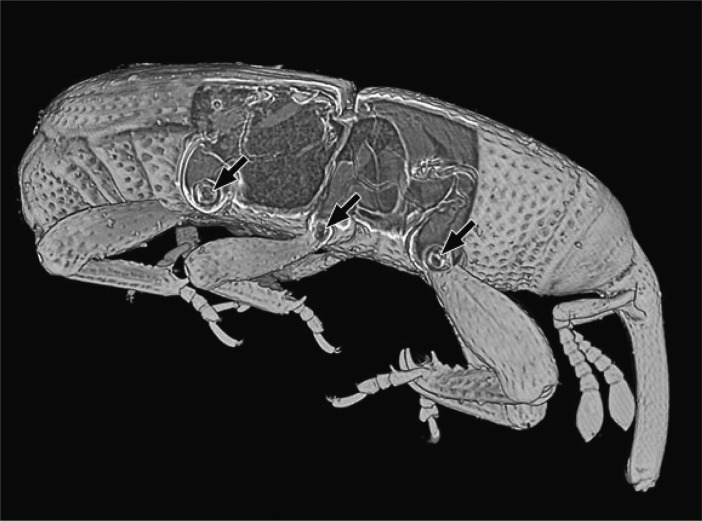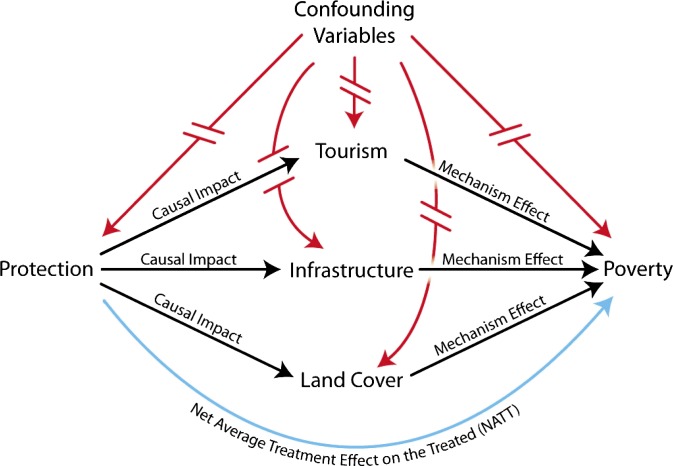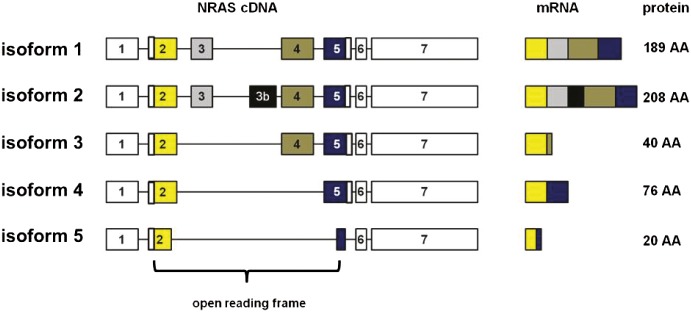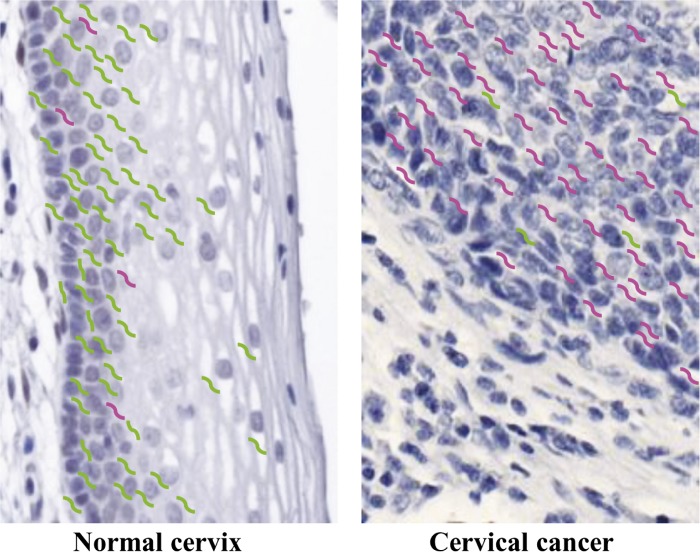Capturing motion inside living organisms in 3D
Time-series of tomographic images reveals 3D movement inside weevil hip joints (arrows).
Motion inside living organisms can be captured by combining X-ray projections taken over time, but the technique only captures movement in two dimensions. Tomy dos Santos Rolo et al. (pp. 3921–3926) developed a technique to capture rapid 3D movement inside living organisms by combining the 2D motion-capturing technique with X-ray microtomography, an imaging technique that collects stacks of X-ray projections to produce 3D images of static organisms. To capture rapid movement in 3D, the authors created a high-speed tomography system to move a live weevil specimen rapidly and precisely through an X-ray beam that could capture stacks of projection images much faster than traditional tomographic systems. The system’s X-ray detector was also optimized to capture images with 2.5 µm spatial resolution. The combination of high-speed 3D imaging and high-throughput data analysis into a single optimized system enabled production of a film showing the morphology of movement inside the hip joints of the live, rapidly moving weevil. According to the authors, the technique can show previously inaccessible morphological dynamics of the internal systems of opaque organisms in real time and in 3D, such as breathing, circulation, digestion, reproduction, and locomotion. — J.J.
Poverty and ecotourism
Directed acyclic graphs depict the empirical strategy for estimating causal mechanism effects. A single-headed arrow represents a causal link or pathway between two variables.
Establishing protected areas in poor regions can lead to reductions in poverty, but the causal mechanisms of these reductions remain unclear. Paul Ferraro and Merlin Hanauer (pp. 4332–4337) examined three potential causes of poverty reduction that are linked to the establishment of protected areas: increased tourism and recreational services; increased infrastructure including roads, health clinics, and schools; and potentially enhanced ecosystem services such as pollination and hydrological services that a protected area may offer. The authors calculated the effects of these potential mechanisms of poverty reduction on the poverty levels within Costa Rican communities that neighbor protected areas. The authors report that ecotourism to protected areas accounted for two-thirds of the observed poverty reduction in surrounding communities, whereas changes in infrastructure and land use had little effect on poverty. The results suggest that conservation programs and policies may be improved through the use of existing data sets, such as poverty estimates from census data, to define the ways in which conservation programs and policies affect human populations. — J.J.
Novel isoforms of the NRAS oncogene
The five naturally occurring NRAS isoforms.
Members of the RAS gene family encode small GTPases, enzymes that regulate cell proliferation and play a central role in carcinogenesis. While cloning cDNA from one such gene, the Neuroblastoma RAS viral oncogene homolog (NRAS), Ann-Kathrin Eisfeld et al. (pp. 4179–4184) identified four hitherto unknown NRAS mRNA isoforms. The novel isoforms (isoforms 2–5) differ from the original (isoform 1) by the absence of one or more exons and parts of exons or, in one case, by insertion of a new exon. Among all five isoforms, the authors report, only the first seventeen amino acids are shared, and three isoforms are missing codon 61, a mutational hotspot. When the authors compared expression patterns of the five mRNA isoforms in normal tissue with tumors from the same patients, they observed subtle but significant differences, varying with isoform and tumor type. When epitope-tagged versions of the five isoforms were expressed in cell culture, they displayed different effects on phosphorylation of downstream genes. Although all five stimulated cell proliferation and transformation, isoform 5, predicted product is a small 20-amino-acid peptide, stimulated the highest levels of phosphorylation, proliferation, and transformation, exceeding of a known NRAS oncogenic allele. According to the authors, identification of these novel isoforms may open pharmacologic approaches to cancers bearing aberrant RAS, previously thought to be “undruggable.” — C.B.
Orphan G-protein–coupled receptor and breast cancer
Roughly 20% of breast cancer cases in women test negative for the three most common and treatable breast cancer cell growth mechanisms. Known as triple-negative breast cancer (TNBC), this disease subtype currently lacks an effective targeted therapy and, as such, is associated with poor outcomes. Citing recent advances aimed at characterizing genetic abnormalities in human tumors, Michael Feigin et al. (pp. 4191–4196) evaluated genomics data and determined that the orphan G-protein–coupled receptor GPR161 is overexpressed in TNBC and correlates with poor prognoses. GPR161, the authors report, forms a complex with two scaffold proteins that regulate signaling via the mammalian target of rapamycin, or mTOR protein. The authors demonstrate that overexpressing GPR161 in human mammary epithelial cells increases cell proliferation and migration, whereas downregulating the gene in a triple-negative breast cancer-derived cell line impairs cell growth and impedes the invasion of other tissues. The findings suggest that GPR161 acts as an important regulator of TNBC and represents a potential diagnostic marker and drug target, according to the authors. — T.J.
L-Carnitine and cardiovascular disease
The intake of L-carnitine, an important nutrient in the human diet, can promote cardiovascular disease via a microbe-mediated pathway that metabolizes the compound to trimethylamine (TMA) prior to absorption. Despite the increasing focus on the essential role of the human microbiota in health and disease, the precise molecular and biochemical mechanisms that convert L-carnitine to TMA remain unclear. Applying a bioinformatics approach, Yijun Zhu et al. (pp. 4268–4273) found a previously uncharacterized Rieske-type protein and associated gene cluster as L-carnitine metabolic candidates, a two-component oxygenase/reductase dubbed cntAB. To validate the prediction, the authors used Acinetobacter baumannii as a model organism to demonstrate that cntAB, a novel group of the Rieske family, is necessary to degrade L-carnitine to TMA. Furthermore, the authors report that overexpression of cntAB in Escherichia coli allows the organism to produce TMA, thus confirming that the genes are sufficient for TMA formation. Taken together, the findings suggest that future research should evaluate Rieske protein inhibitors as a therapeutic target for preventing TMA formation, according to the authors. — T.J.
Potential biomarker for cervical cancer
Normal cervical cells express certain miRNAs (green) in greater abundance than do cells infected by oncogenic papillomavirus, which preferentially express different miRNAs (pink).
Infections by high-risk human papillomaviruses (HPV) are the leading cause of cervical cancer and can also lead to penile, anal, and oropharyngeal carcinomas. Detection of HPV infections is largely limited to exfoliated cell cytology, histology of tissue biopsies, and the presence of viral nucleic acids. Xiaohong Wang et al. (pp. 4262–4267) investigated whether the expression of host cell-encoded microRNAs (miRNAs), which become dysregulated in many cancers, could serve as additional biomarkers for high-risk HPV infection. Foreskin or vaginal epithelial cells infected in vitro with either HPV16 or HPV18 resulted in increased or decreased expression of the same 13 miRNAs. Dysregulation of eight of these miRNAs was attributed to viral oncoproteins E6 and E7, known to turn some cells cancerous. Analysis of 158 cervical tissues revealed that the relative abundances of four of the eight dysregulated miRNAs, in particular, the ratio of miR-25 and miR-92a to miR-22 and miR-29a, could be used to distinguish normal tissue from precancerous and cancerous tissues. According to the authors, only 13.2% of healthy cervical tissues expressed a miRNA ratio equal to or greater than 1.5. In contrast, 38–48% of precancerous tissues carried a higher ratio, as did 88.2% of cancerous tissues, suggesting that alterations in the expression of certain miRNAs may be used as biomarkers to diagnose precancerous and cancerous cervical infections. — J.J.






